Ground Cover Plants in Florida (With Pictures) – Identification Guide
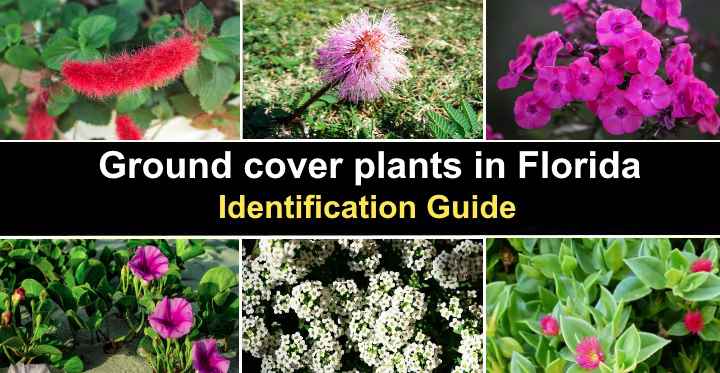
Choosing ground cover plants for a Florida landscape doesn’t have to be challenging. Many creeping, ground-hugging plants are well-suited to growing in Florida’s unique climate. Spreading flowering ground cover plants are perfect for planting in full sun in the Sunshine State. However, several varieties of mat-forming plants for shade also thrive in warm, humid climates like the southeastern United States.
The growing zones in Florida mean you must choose wisely the right type of ground cover plants. For example, Florida’s northern and central regions (USDA zones 8 and 9) can have cold winters but warm, humid summers. However, south of Lake Okeechobee (USDA zones 10 and 11), southern Florida has subtropical temperatures throughout the year.
When choosing ground cover plants for a Florida landscape, check the plant’s growing zone, sun exposure needs, and care requirements. It is also best to choose native Florida ground cover plants to prevent invasive species from taking over your garden.
This article is a guide to selecting the best ground cover plants for Florida landscapes. In addition, you will find descriptions and pictures of low-growing, spreading plants suitable for sun or shade in USDA zones 8 through 11.
Types of Florida Ground Cover Plants
Ground cover plants for growing in Florida are typically heat and drought-tolerant plants that don’t grow taller than 12” (30 cm). The best plants for full sun or shade ground cover should have a creeping, trailing, or spreading habit without taking over your garden. The best ground cover plants for Florida are for warm to subtropical climates.
Planting ground cover plants in a Florida garden has several beneficial uses. The spreading green foliage helps to cover bare ground. Additionally, ground cover plants protect the soil from erosion, lock in moisture, and prevent the sun from scorching the soil.
Native Florida Ground Cover Plants
Planting ground cover plants native to Florida and the southeastern US is ideal to ensure a healthy garden landscape. Native Florida plants are adapted to growing in constant sunshine and heat. Additionally, fast-growing ground cover plants don’t become invasive.
Let’s look at seven varieties of low-growing, ground-hugging plants native to Florida.
Lemon Bacopa (Bacopa caroliniana)

Lemon bacopa is an attractive low-growing perennial herbaceous plant native to Florida. The creeping plant has pale bluish-purple, star-shaped flowers, tiny lemon-scented oval leaves, and a fast-growing habit. This mat-forming plant thrives in sandy soils and coastal regions and can grow in marshy areas or underwater.
Lemon bacopa thrives in full sun or partial shade. The plant is perfect for growing to cover ground on slopes near ponds, streams, or water gardens. Additionally, it is perfect growing in a hanging basket where its foot-long (30 cm) trailing stems add a vertical accent.
Growing conditions: Full sun and saturated soils.
Size: 6” to 12” (15 – 30 cm) tall and 20” to 40” (50 – 100 cm) wide.
Zones: 8 to 11.
Beach Verbena (Glandularia maritima)
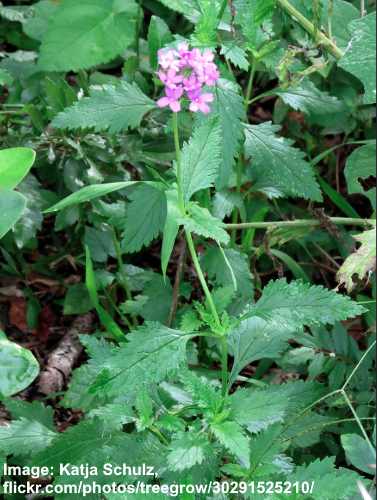
The beach verbena is a decorative low-growing evergreen perennial with small four-petalled pink flowers. Native to Florida’s east coast, beach verbenas thrive in sunny locations along beaches and dunes. The creeping, prostrate leafy stems help prevent dune erosion and are ideal for ground cover in sunny gardens.
Spreading beach verbena is characterized by its ovate leaves with toothed margins. The mat-forming plant blooms throughout the year in Florida, adding pink and lavender colors to landscapes, especially in spring and summer. This drought and salt-tolerant creeping plant is ideal for growing in mass plantings as colorful ground cover.
Growing conditions: Full sun, well-drained moist loamy or sandy soils.
Size: 8” to 12” (20 – 30 cm) tall and 36” to 60” (90 – 150 cm) wide.
Zones: 8 to 11.
Partridge Berry (Mitchella repens)
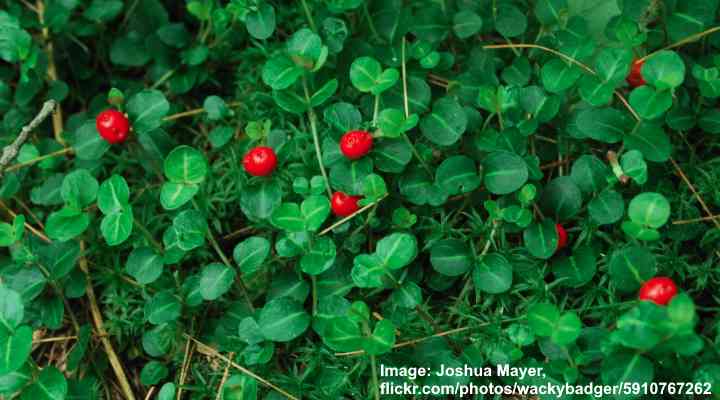
Partridge berry is an attractive ground-hugging plant for Florida with lush green foliage and attractive red berries. The ground cover plant spreads via rooting and trailing stems. Suited for growing in northern and central Florida, this creeper plant is known for its ornamental foliage and small trumpet-shaped spring flowers.
Partridge berry evergreen ground cover plants have white flowers that appear in spring. These are followed by vibrantly colored red berries that persist on the shrub through winter. The carpet-forming plant is ideal for rock gardens, shaded beds, understory planting, and evergreen ground cover for shade.
Growing conditions: Partial shade to full shade growing in well-drained, acidic soil.
Size: 1” to 2” (2 – 5 cm) tall and 6” to 12” (15 – 30 cm) wide.
Zones: 3 to 9.
Baby Rubber Plant (Peperomia obtusifolia)
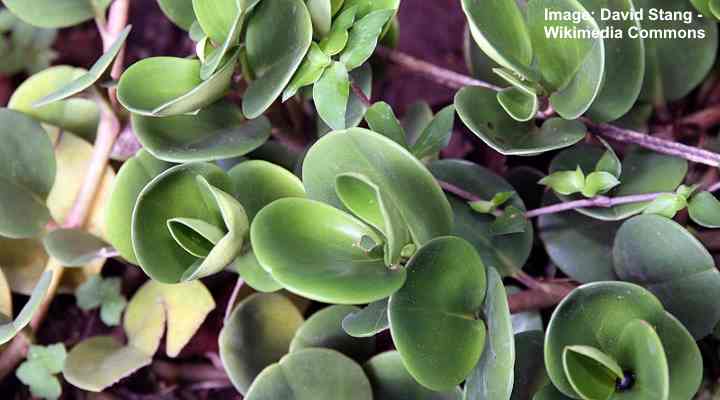
The baby rubber plant is perfect for growing in the shade throughout Florida. The low-maintenance spreading plant has shiny green leaves, creamy-white flowers, and a clumping habit. The showy, evergreen lush foliage grows on short reddish stems giving the plant year-long appeal. In tropical landscapes, the dwarf rubber plant blooms periodically throughout the year.
The baby rubber plant is well-suited to tropical shaded gardens where it thrives without sunlight. Its trailing stems spread over the ground creating a cushion of attractive foliage. It’s good to note that you can also grow this peperomia variety indoors in hanging baskets in temperate climates.
Growing conditions: Partial sun to complete shade, well-drained, organically rich, or sandy soil.
Size: 6” to 12” (15 – 30 cm) tall and wide.
Zones: 9 to 12
Beach Morning Glory (Ipomoea imperati)
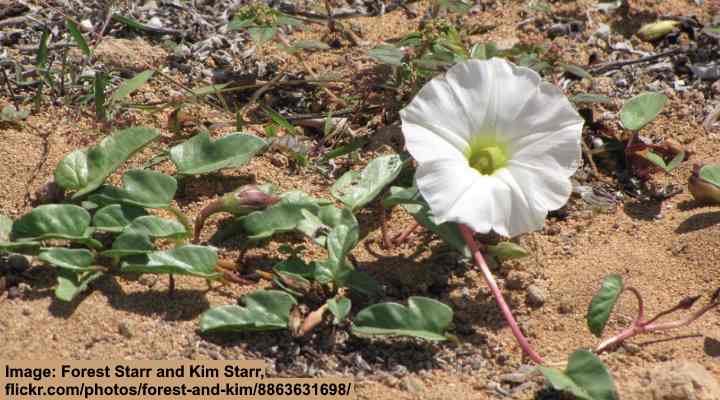
Beach morning glory is an attractive native plant that spreads over the ground forming a blanket of lush foliage. The trailing stems have fleshy dark green leaves and large trumpet-shaped white flowers that thrive in tropical climates. Beach morning glory thrives in all-day long sunshine, especially in coastal areas.
Suitable for growing throughout Florida, beach morning glory is a perfect ground cover plant for sandy soil. For dense foliage ground cover, you can plant this sand-stabilizing plant around beachfront homes or coastal landscapes. Additionally, the long-trailing stems look attractive, cascading over a container or hanging basket.
Growing conditions: Full sun in dry, well-drained sandy soil.
Size: 4″ to 6″ (10 – 15 cm) tall and 10 to 15 ft. (3 – 15 m) wide.
Zones: 8 to 11.
Carolina Wild Petunia (Ruellia caroliniensis)
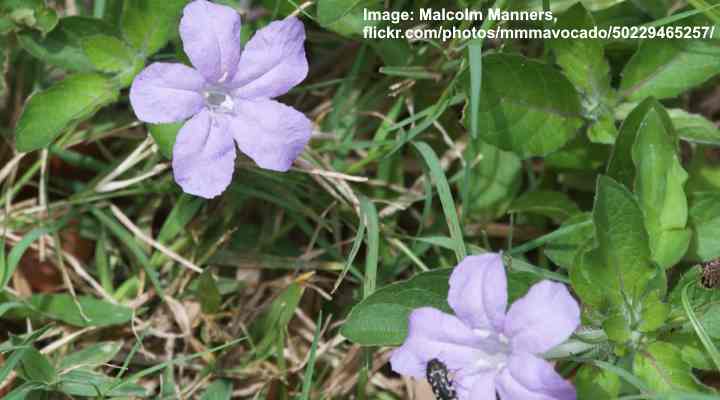
Carolina wild petunia is a spreading drought-tolerant, easy-to-grow Florida ground cover plant. This attractive native plant has large lilac or light-purple blooms in a funnel shape. The long-blooming five-petalled purple flowers contrast nicely with rich green lanceolate leaves, covering the ground with dense foliage as they brighten shaded gardens.
As a heat-loving, shade-tolerant spreading perennial, Carolina wild petunia is ideal for growing in North and Central Florida. Its trailing stems easily spread, and the flowers readily reseed, making it easy to cover ground rapidly. As well as planting for ground cover, this flowering plant is ideal for a hanging basket or covering a retaining wall.
Growing conditions: Part sun to full shade in clay, loam, or sandy soils with excellent drainage.
Size: 6″ to 12″ (15 – 30 cm) tall and 12″ to 24″ (30 – 60 cm) wide.
Zones: 8 to 11.
Sea Purslane (Sesuvium portulacastrum)
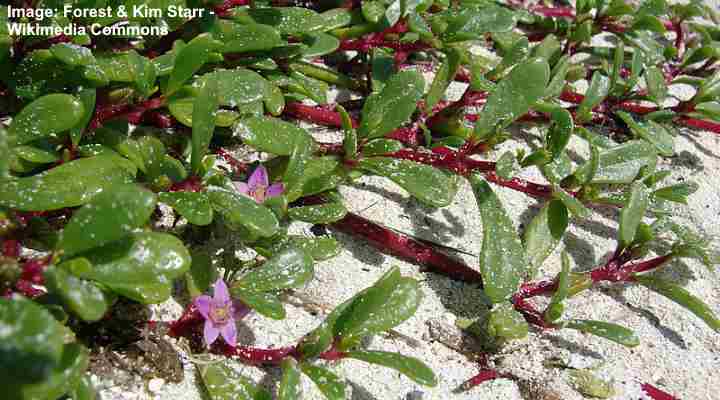
Sea purslane is an attractive ground-spreading plant for Florida with succulent ovate leaves growing on reddish stems. The low-growing evergreen is perfect for growing in coastal landscapes where sandy soil is abundant. The mat-forming plant has pretty, star-shaped pink flowers blooming throughout the year. Additionally, the succulent leaves have reddish or yellow tips in full sun.
The fast-growing ground cover plant with a vining habit thrives in most soil conditions and requires little care. Once established, it is tolerant of drought and salty conditions, making it an ideal landscaping plant for seaside gardens in Florida’s harsh climate. It doesn’t matter if you are in the panhandle, Miami, or the Florida Keys, sea purslane will grow well.
You can grow sea purslane in containers or let the succulent vines trail from hanging baskets.
Growing conditions: Full sun or light shade growing in dry or moist, well-drained soils.
Size: 6” to 12” (15 – 30 cm) tall and 36” to 60” (90 – 150 cm) wide.
Zones: 9 to 13.
Florida Ground Cover Plants for Shade
Ground cover plants that need less light should survive on four hours of sunlight or less. However, finding shade-loving plants for Florida’s climate can be challenging. The good news is that many varieties of creeping plants grow well in the shade, heat, and humidity.
Heartleaf Philodendron (Philodendron hederaceum var. oxycardium)
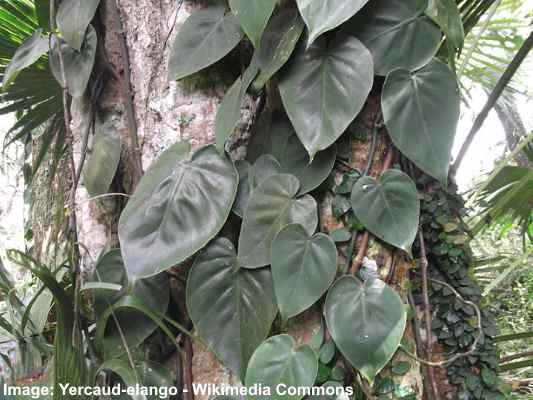
Trialing heartleaf philodendron is a shade-loving ground cover plant for growing in southern Florida. The trailing plant grows rapidly, quickly creating a green carpet of heart-shaped leaves in the shade. These glossy green leaves grow 2” to 4” (5 – 10 cm) wide. In temperate climates, heartleaf philodendron is a popular indoor houseplant.
This beautiful, low-maintenance plant will spread with trailing vines and grow up to 72” (180 cm) long. The rapidly growing ground cover thrives in partial shade to deep shade, making it an ideal landscaping solution for north-facing gardens, growing under shrubs, or in constant shadows.
Growing conditions: Partial shade to deep shade with fewer than 3 hours of sunlight and moist, well-draining soil.
Size: 4” (10 cm) tall and up to 72” (180 cm) wide.
Zones: 10 and 11.
Peacock Ginger (Kaemferia)
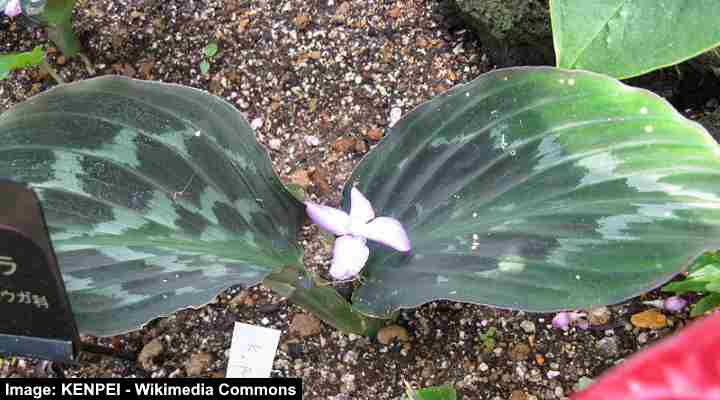
Kaempferia pulchra
Peacock ginger is a shade-tolerant plant for growing as ground cover in Florida landscapes. The ground-hugging plant is identified by its oval or round leaves with green, purple, silver, or bronze coloration. The trailing stems gradually spread to cover large areas in most soil types — as long as they get fewer than 2 hours of sunshine daily.
Peacock ginger plants are also flowering ground cover for shade and bloom with small purple or pink flowers throughout the summer. Ideal for a shade garden, peacock ginger will also grow well under shrubs, in dappled sunlight, or along a shaded fence line. The attractive lance-shaped leaves grow 4” to 10” (10 – 25 cm) long.
Growing conditions: Partial shade to full shade growing in average, well-drained soil.
Size: 4” to 6” (10 – 15 cm) tall and up to 24” (60 cm) wide.
Zones: 8 to 11.
Golden Pothos (Epipremnum aureum)
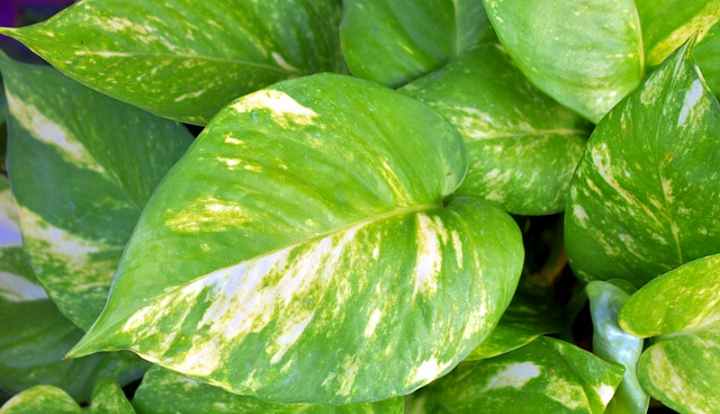
Golden pothos is a spectacular shade-loving ground cover plant with colorful foliage that thrives in southern Florida. The vining plant quickly covers bare ground with its bright green and golden yellow leaves. Due to its scrambling nature, golden pothos will also climb up trees, trellises, or pergolas, creating attractive foliage features in the landscape.
Growing as ground cover in the shade, golden pothos spreads 13 to 40 ft. (4 – 12 m) wide. Its attractive heart-shaped leaves are 3” to 4” (7.5 – 10 cm) long and grow alternately on long green stems.
Because it’s only suitable for growing outdoors in tropical regions, this tropical plant is typically grown as an easy-care evergreen houseplant.
Growing conditions: Dappled sunlight, partial shade, or full shade growing in average, well-drained soil.
Size: Up to 6” (15 cm) tall and 40 ft. (12 m) wide.
Zones: 10 to 12.
Related reading: How to care for a pothos houseplant.
Dwarf Oyster Plant (Tradescantia spathacea ‘Dwarf’)
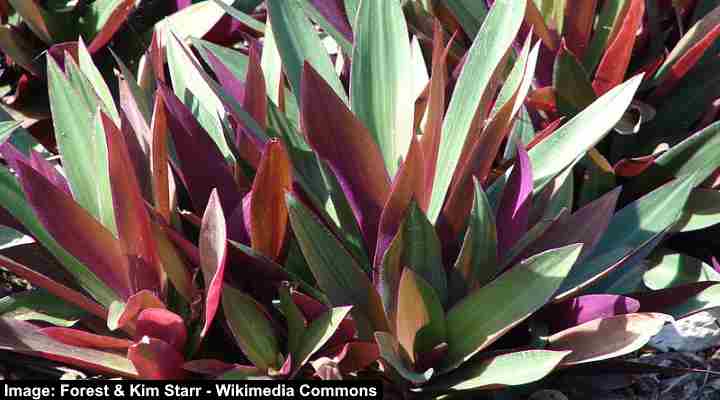
This dwarf oyster plant thrives in the shade, creating a dense bed of green and purple foliage. The low-growing spreading plant has stiff, sword-shaped leaves growing 7” to 14” (17 – 35 cm) long, small white flowers, and a clumping habit.
The dwarf oyster plant is an excellent choice for mass planting in partial to full shade in South Florida. You can grow it as an edging, border plant, or mass planting to fill empty spaces. This variety is easy to care for and will thrive in most conditions.
If the dark green and purple foliage is too dark, you can plant the Tradescantia spathacea ‘Tricolor’ cultivar. This attractive ground cover plant has bright pink, green, and white blade-like foliage.
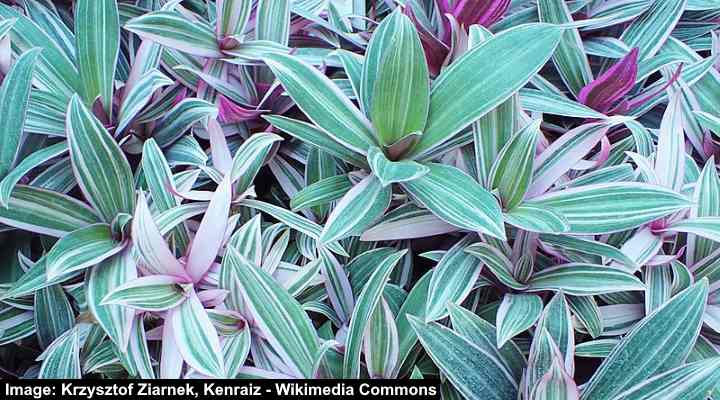
Tradescantia spathacea ‘Tricolor Minima’
Growing conditions: Partial shade and growing well-drained soil.
Size: 8” to 12” (20 – 30 cm) tall and 24” (60 cm) wide.
Zones: 10 and 11.
Cast Iron Plant (Aspidistra elatior)
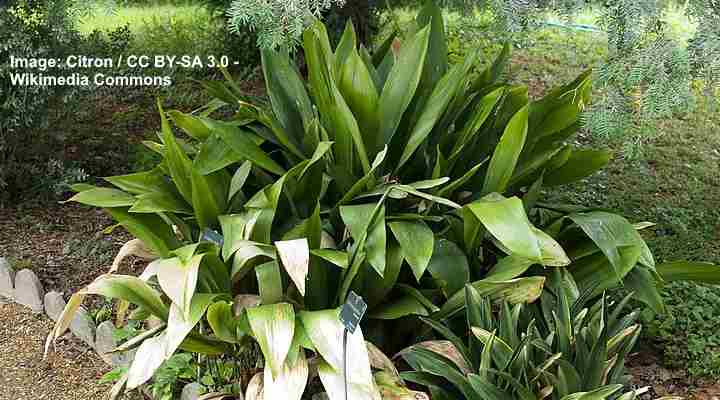
The cast iron plant is a tough, clumping ground cover plant suitable for shade gardens in all regions of Florida. The hardy, leafy foliage plant has huge lanceolate leaves that grow nearly 2 feet (60 cm) tall. It spreads through its rhizomatous roots, creating larger clumps and filling empty landscape spaces.
Growing the cast iron plant is an excellent landscaping solution for challenging shaded conditions. As its name suggests, the plant is “as tough as nails” and survives short cold snaps just as well as hot, humid conditions. This evergreen perennial is also ideal as an indoor houseplant in rooms with little light.
Growing conditions: Full sun to full shade and growing in rich, fertile soil that has excellent drainage. However, it will adapt to most growing conditions.
Size: 12” to 20” (30 – 50 cm) tall and 18” (45 cm) wide.
Zones: 7 to 11.
Sweet Potato Vine (Ipomoea batatas)
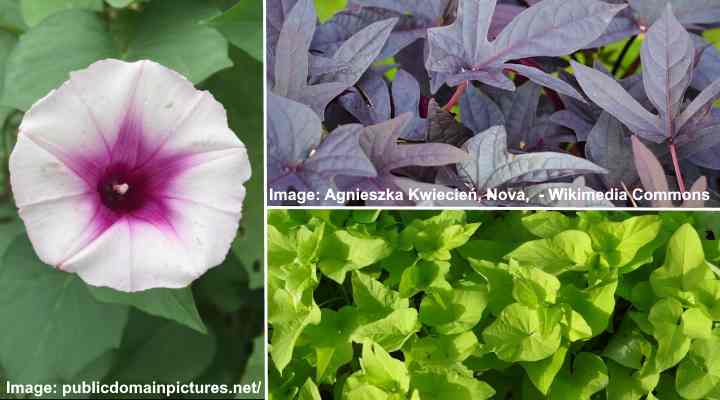
Sweet potato vine flower (left image), Ipomoea batatas ‘Purple’ (top), Ipomoea batatas ‘Marguerite’ (bottom)
Sweet potato vine is a beautiful flowering ground cover plant in a subtropical Florida climate that thrives in the shade or sun. The attractive features of this landscaping vining plant are its colorful foliage in chartreuse, bronze, or purple colors – depending on the cultivar. In addition, the spreading plant grows well without much care and only requires occasional pruning to control its spread.
As a heat-loving hardy plant, the sweet potato vine is suitable for growing throughout Florida. In addition, the heart-shaped leaves come in various colors depending on the cultivar. Therefore, you can choose the right variety to enhance your landscape’s aesthetics.
Growing conditions: Full sun to full shade and growing in rich, fertile soil that has excellent drainage. However, it will adapt to most growing conditions.
Size: 9” (22 cm) tall and 10 ft. (3 m) wide.
Zones: 9 to 11.
Flowering Ground Covers For Florida
Growing ground cover plants with spectacular blooms can add a bang of color to your Florida landscape. But which are the best varieties of flowering ground cover plants to grow in the Sunshine state? Please read on to find out.
Society Garlic (Tulbaghia violacea)

Society garlic is an easy-to-grow perennial herbaceous plant suitable as ground cover in all areas of Florida. The slowly-spreading clumping plant produces inflorescences of pale purple tubular flowers growing on long stems. These emerge from attractive, grass-like, evergreen foliage that gives off a garlicky scent when crushed.
Society garlic is a popular landscaping plant in Florida landscapes. The light lilac tubular flowers open in to look like six-pointed stars. Although not a member of the garlic family, the foliage and roots are edible and have a delicate garlic taste. Additionally, the hardy plant tolerates light frosts and humid conditions.
Growing conditions: Full sun to full shade and growing in rich, fertile soil that has excellent drainage. However, it will adapt to most growing conditions.
Size: 9” (22 cm) tall and 10 ft. (3 m) wide.
Zones: 9 to 11.
Beach Sunflower (Helianthus debilis)
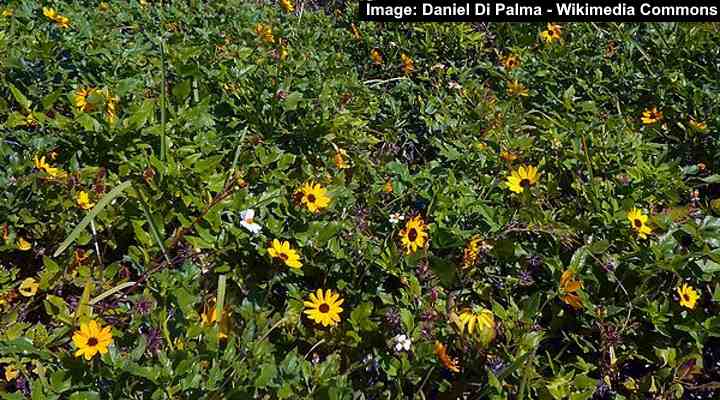
Beach Sunflower plants are native to southeastern North America and thrive in coastal regions. The attractive yellow-flowering ground cover plants have sunflower-like blooms, dark green deltoid leaves, and a fast-growing habit. Furthermore, the salt and drought-tolerant plant thrives in landscapes along the Florida coast.
Beach sunflower plants are self-seeding and spread without much intervention. The heat-hardy plants are identified by their flowers 3” (7.5 cm) across, long triangular leaves 4” (10 cm) long, and tall flowering stems. The large yellow flower heads attract butterflies and hummingbirds to southern gardens.
Growing conditions: Full sun growing in acidic, sandy well-draining soils.
Size: 12″ to 24″ (30 – 60 cm) tall and 24″ to 48″ (60 – 120 cm) wide.
Zones: 8 to 11.
Sunshine Mimosa (Mimosa strigillosa)

Sunshine mimosa is an attractive carpet-forming flower commonly found in its native habitat of Florida. The flowering plant is identified by its pinnately compound mimosa leaves and fuzzy globular pink flowers. This plant grows low to the ground and helps transform a barren landscape into lush vegetation.
Sunshine mimosa is described as a sensitive plant because its tiny leaves fold together when touched. The ball-shaped pink flowers measure 1” (2.5 cm) across and bloom on erect stems. After flowering, flattened seed pods appear. This plant is ideal for full-sun conditions and is perfect for growing in drought-prone areas.
Growing conditions: Full sun to partial sun in dry to moist, well-draining soil.
Size: 6” to 24” (15 – 60 cm) tall and 10 to 100 ft. (3 – 30 m) wide.
Zones: 8 to 10.
Asiatic Jasmine (Trachelospermum asiaticum)
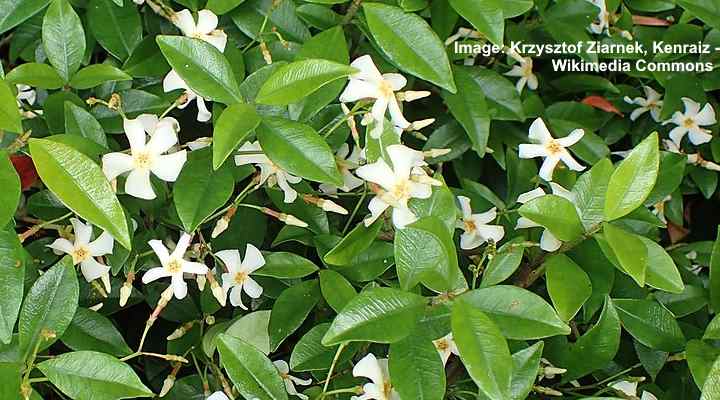
Asiatic jasmine is a white-flowering evergreen shrub with twining stems covered in dark leaves. Suitable for growing in all of Florida, this spreading, luscious evergreen plant has star-shaped, creamy-white jasmine-like fragrant flowers. The dense foliage creates a carpet along the ground, protecting the soil and preventing weed growth.
Asiatic jasmine, with its attractive foliage and blossoms, is an ideal landscaping choice for full sun ground cover. Additionally, the climbing vines will grow up an arbor, trellis, or pergola. Or, you can grow the beautiful plant in hanging baskets to enjoy its cascading green and white colors.
Growing conditions: Full sun to partial sun in fertile, well-drained soil.
Size: 6” to 12” (15 – 30 cm) tall and 15 to 20 ft. (4.5 – 6 m) wide.
Zones: 7 to 11.
Perennial Peanut Ground Cover Plants (Arachis glabrata)
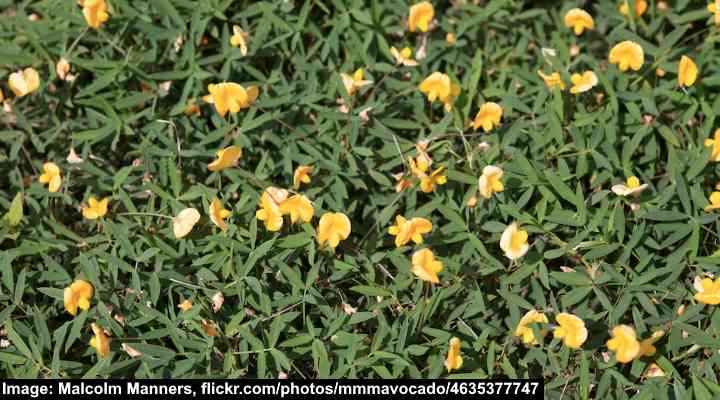
Perennial peanut plants are versatile native Florida plants that cover the ground with beautiful yellow flowers and lush green foliage. The mat-forming habit of perennial peanut plants makes them a good alternative to grass that gets light foot traffic. In South Florida, you can interplant it with ryegrass to maintain a lush lawn throughout the winter.
Perennial peanut plants are ideal for tropical climates because they are drought-tolerant and require little water. Growing in full sun encourages prolific flowering throughout the year. In addition, the carpet-forming plants are ideal for preventing soil erosion on slopes.
Growing conditions: Full sun to partial sun in dry, loamy, or sandy well-draining soil.
Size: 6” to 8” (15 – 20 cm) tall and space them 24” (60 cm) apart to allow the plants to spread over the ground.
Zones: 9 to 11.
Railroad Vine (Ipomoea pes-caprae)
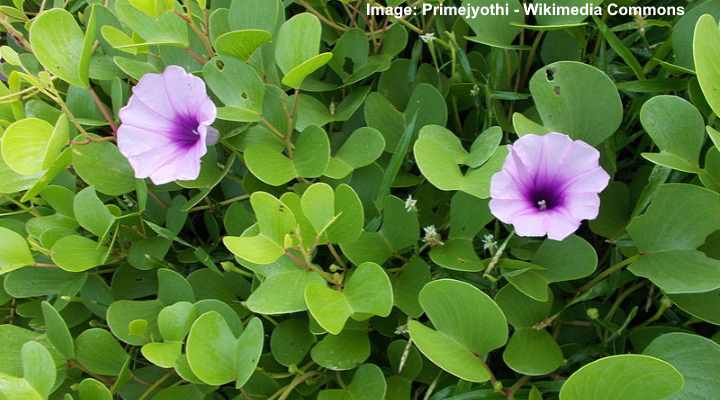
Railroad vine is a stunning ground cover plant to add a splash of color to your Florida landscape. Whether you live in the panhandle, on the east coast in Miami, or west in Naples, this creeping plant will beautify your landscape. Large trumpet-shaped pink and deep purple flowers and large dark green leaves spread freely across the ground.
Railroad vine, with its showy flowers, is ideal for ground cover on nutrient-deficient, dry soils. In addition, the vining, creeping plant helps enhance beachfront homes, dry landscapes, and sunny gardens. This fast-growing carpet-forming plant isn’t invasive in Florida.
Growing conditions: Full sun in dry to moist nutrient-poor soil.
Size: 4” to 6” (10 – 15 cm) tall and 10 to 60 ft. (3 – 18 m) wide.
Zones: 8 to 11.
Sweet Alyssum (Lobularia maritima)
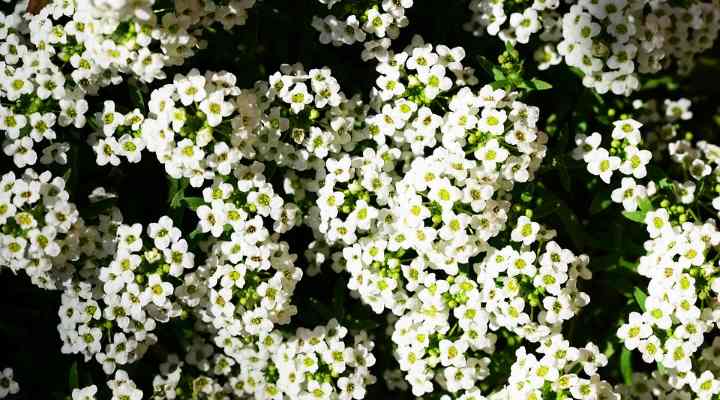
Sweet alyssum is an easy-care mounding plant that blooms throughout winter with fragrant white, purple, or pink flowers. Planted in the ground, sweet alyssum creates a one-foot (30 cm) tall blanket of white blossoms that smell like honey. The plant is self-seeding, heat-tolerant, and withstands full sun.
Sweet alyssum grows well in most soils and climates. The carpet of white flowers attracts pollinators like bees and butterflies to gardens in the southeast. Additionally, you can plant sweet alyssum in rock gardens, use it as edging, or let the flowering stems cascade over a hanging basket.
Growing conditions: Full sun to partial sun in dry to moist, well-draining soil.
Size: 6” to 24” (15 – 60 cm) tall and 10 to 100 ft. (3 – 30 m) wide.
Zones: 8 to 10.
Baby Sun Rose (Aptenia cordifolia)

Baby sun rose is an attractive low-growing plant that thrives in southern Florida and the Florida Keys. The trailing succulent forms a thick mat on the ground of fleshy heart-shaped leaves and dainty red flowers. The tiny attractive leaves are lime green with creamy-white edging, and its flowers bloom throughout the year.
Baby sun rose only grows around half a foot (15 cm). This ground-hugging succulent for subtropical climates is a low-maintenance plant. Its green foliage and pinkish-red flowers also look attractive cascading over walls, containers, or hanging baskets. With its tolerance for drought and salt, this succulent is perfect for coastal gardens south of Cape Coral and West Palm Beach.
Growing conditions: Full sun growing in sandy, well-draining soil.
Size: 6” (15 cm) tall and 24” (60 cm) wide.
Zones: 10 and 11.
Ice Plant or Sea Fig (Carpobrotus chilensis)

Ice plant is an easy-care ornamental ground cover succulent with fleshy green leaves and showy vibrant pink flowers. Ideal for the warmth of South Florida, this mat-forming plant has stems that spread out over the ground and take root. Its thick, pointed triangular leaves develop red tips in full sunlight.
Also called sea fig, the ice plant has many uses in subtropical gardens. Its low growth and tolerance for drought make it ideal for filling edges, planting in rock gardens, or allowing it to spread over the ground.
Growing conditions: Full sunlight and growing in dry ground.
Size: 6” tall and 6.5 ft. (2 m) wide.
Zones: 10 and 11.
Coral Creeper (Barleria repens)

Coral creeper is an attractive ground cover that’s a fast grower in warm climates. The spreading, shrubby plant has beautiful trumpet-shaped pink flowers, oval, egg-shaped leaves, and a low-growth habit. As the ground-hugging stems spread, they root in the soil, making coral creeper ideal for preventing soil erosion or covering bare ground.
The outstanding feature of coral creeper for ground cover is its large exotic coral red flowers. These funnel-shaped blooms appear periodically throughout the year, adding a splash of color to southern gardens. Additionally, coral creeper grows well as a foundation planting, climbing vine, or edging plant.
Growing conditions: Full sun to partial sun in dry to moist, well-draining soil.
Size: 20” to 27” (50 – 70 cm) tall and 6.5 ft. (2 m) wide.
Zones: 10 and 11.
Annual Phlox (Phlox drummondii)
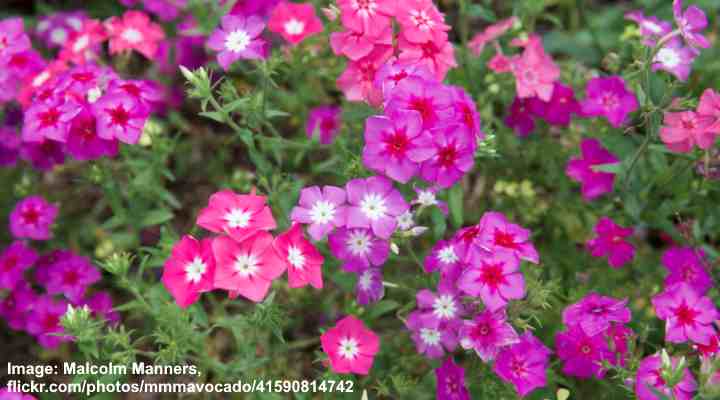
Annual phlox is a native mat-forming flowering plant that transforms subtropical landscapes into a sea of color. The low-growing creeping shrubs have colorful, fragrant blossoms and small lanceolate leaves. Not growing more than two feet (60 cm) tall, fast-growing annual phlox is perfect for Florida gardens.
Phlox drummondii cultivars are the varieties that tolerate southern Florida’s heat. Varieties of annual phlox bloom in shades of pink, mauve, white, and lilac. In addition to planting annual phlox as flowering ground cover, the trailing stems, showy flowers, and attractive foliage look spectacular in patio containers or as a border.
In colder climates, this variety of phlox grows as an annual. However, in warm-winter regions, it grows throughout the year in the ground.
Growing conditions: Full sun to partial sun in fertile, well-drained soil. In the hottest parts of Florida, it may require protection from the hot afternoon sun.
Size: 16” (40 cm) tall and 12” (30 cm) wide.
Zones: 2 to 11.
Creeping Phlox (Phlox subulata)
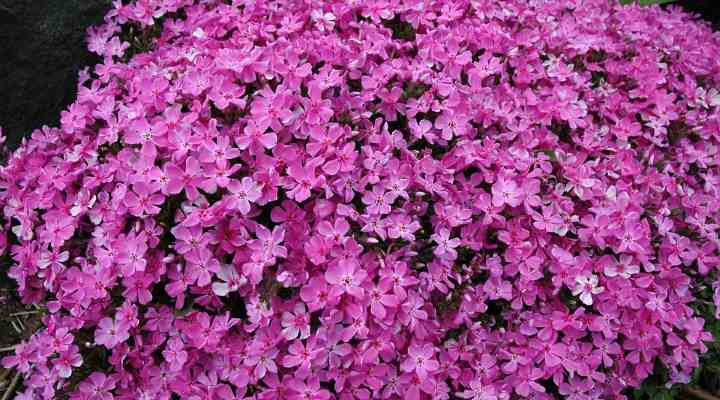
Creeping phlox is a hardy, carpet-forming perennial that thrives in northern Florida. This phlox variety grows as a flowering perennial and blooms throughout the summer. The ground-hugging plant is identified by its dainty pinwheel flowers in shades of red, pink, lavender, or white. In addition, attractive tiny lance-shaped leaves grow on creeping stems.
Creeping phlox is perfect for adding lush foliage and colors to summer gardens where temperatures sometimes fall below freezing. This sun-loving plant spreads several feet, creating a flowering mat in sunny gardens. You can also plant phlox in rock gardens, at the front of beds, or as perennial ground cover.
Growing conditions: Full sun and well-draining soils with medium moisture. It also tolerates saline and alkaline soil.
Size: 6” to 8” (15 – 20 cm) tall and 24” to 36” (60 – 90 cm) wide.
Zones: 5 to 8.
Dwarf Chenille (Acalypha reptans)
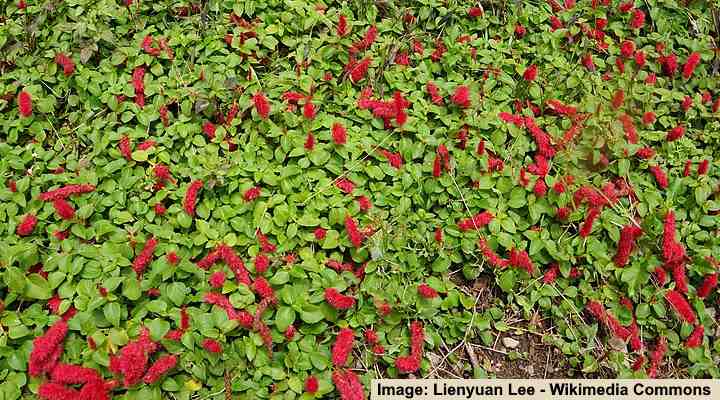
Dwarf chenille is an attractive low-growing ground cover plant with red fuzzy bottlebrush flowers and lush green foliage. Freely spreading across the ground, dwarf chenille has eye-catching bright red flowering spikes. These unusual flowers contrast well with the dark green, ovate leaves in gardens that enjoy sunshine throughout the day.
Also called strawberry firetails or cat tail, dwarf chenille is easy to care for. Apart from covering the ground in tropical landscapes, dwarf chenille is an ideal plant for hanging baskets and containers or edging a driveway. In addition, you can enjoy its tropical beauty growing it as a houseplant in colder climates.
Growing conditions: Full sun or partial sun in moist, humus-rich, well-draining soil.
Size: 12” to 18” (30 – 45 cm) tall and wide.
Zones: 9 to 11.
Red Creeping Thyme (Thymus praecox ‘Coccineus’)
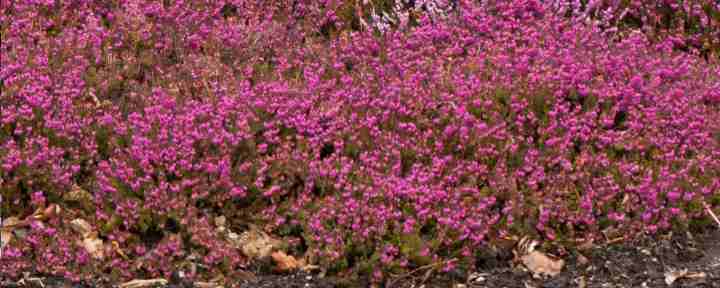
Red creeping thyme is an attractive ground-hugging herbaceous plant covered in masses of pinkish-red flowers. The aromatic creeping shrub features tiny flowers that create a carpet of pinks and reds in a tropical landscape. Additionally, tiny dark green glossy leaves form a dense cushion, adding texture and color to a landscape.
Suitable as ground cover for all areas of Florida north of Lake Okeechobee, red creeping thyme thrives in full sun, requiring little care. Also called “mother of thyme,” the mat-forming shrub gives off herby aromas when the foliage is crushed. The bloom time of red creeping thyme is from mid-summer through to early fall.
In addition to growing as a ground cover, red creeping thyme is a beautiful alternative to turfgrass.
Growing conditions: Full sun to partial sun in dry to moist, well-draining soil.
Size: 6” to 24” (15 – 60 cm) tall and 10 to 100 ft. (3 – 30 m) wide.
Zones: 8 to 10.
Related reading: Varieties of creeping thyme.
Other Ground Cover Plants to Grow in Florida
Creeping Fig (Ficus pumila)
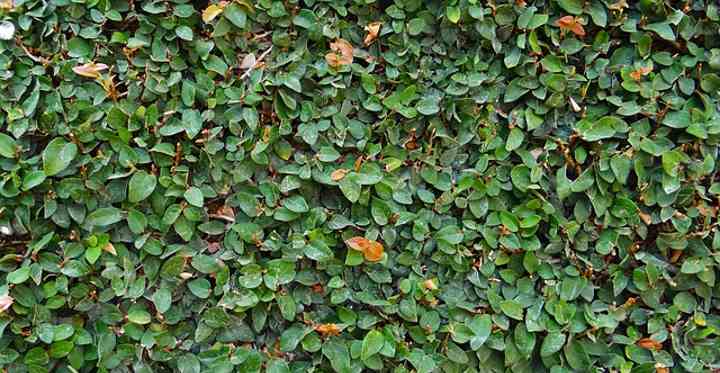
Creeping fig plants are fast-growing vining plants that can quickly cover ground in the southeast. This vigorous creeping plant is characterized by its 2” (5 cm) heart-shaped leaves growing on woody stems. In warmer climates, creeping fig also produces pear-shaped fruits throughout the year. The vine can also cover walls, fences, and trellises.
When growing creeping fig as ground cover, you need to prune it regularly to prevent it from climbing trees or shrubs. It grows best in direct sunlight but will tolerate partial shade.
You can also grow creeping fig as an evergreen indoor vining plant.
Growing conditions: Full sun to partial shade in humus-rich, moist soil that drains well.
Size: 0.5” to 1.5” (1.3 – 4 cm) tall and 36” (90 cm) wide. When grown as a climber, creeping can reach 15 ft. (4.5 m) high.
Zones: 9 to 11.
Low-Growing Juniper Ground Cover Shrubs
Juniper shrubs are excellent for landscaping in North Florida because they tolerate humid climates and freezing winters. Cultivars of the low-growing evergreen coniferous plants don’t grow more than a few feet tall. However, they form a dense evergreen mat of aromatic foliage and keep their color throughout the year.
Here are suitable varieties of juniper ground cover plants for northern regions of Florida:
- Juniperus horizontalis — Grows 12” (30 cm) tall and spreads up to 10 ft. (3 m).
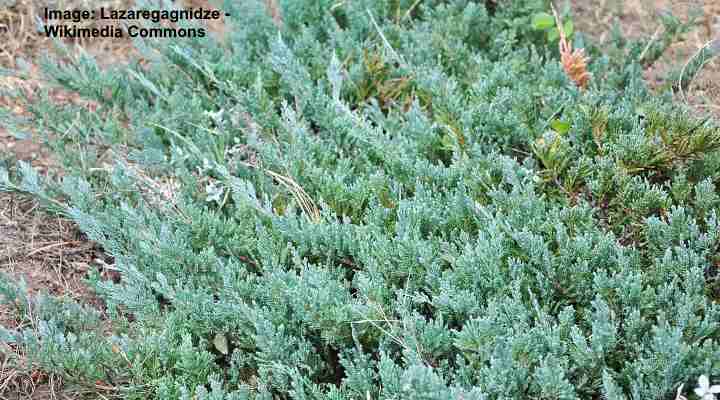
Creeping Juniper (Juniperus horizontalis)
- Juniperus procumbens ‘Nana’ — Grows 12” (30 cm) tall and 6 ft. (1.8 m) wide.
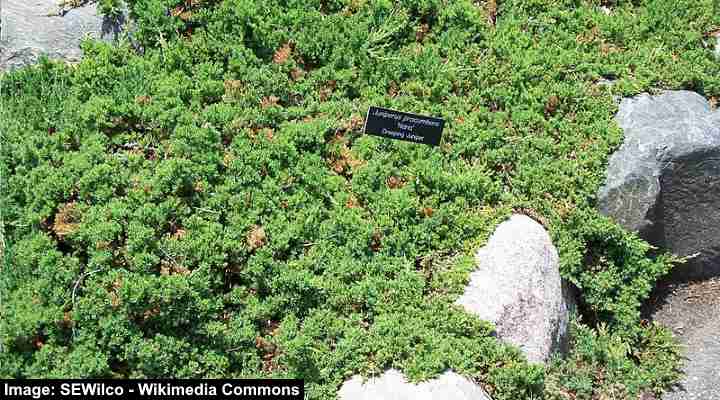
Dwarf Japanese Garden Juniper (Juniperus procumbens ‘Nana’)
- Juniperus conferta ‘Blue Pacific’ — Grows up to 12” (30 cm) tall with a spread up to 7 ft. (2.1 m).
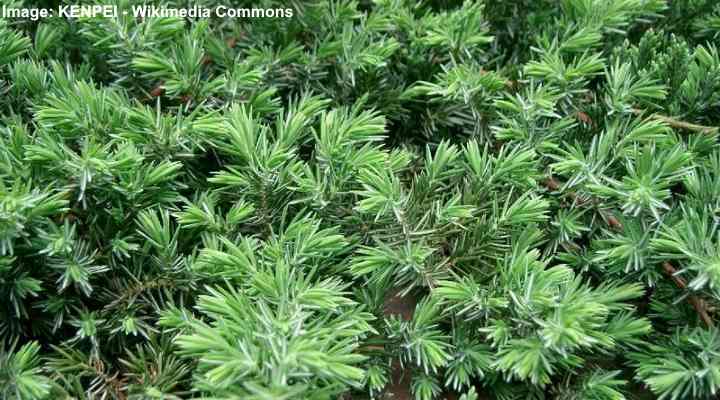
Blue Pacific Shore Juniper (Juniperus conferta ‘Blue Pacific’)
Growing conditions: Full sun in average soils that are kept moist without becoming soggy.
Size: 12 (15 cm) tall and 3 to 7 ft. (1 – 2.1 m) wide.
Zones: 4 to 8.
Coral Honeysuckle (Lonicera sempervirens)

Coral honeysuckle is a vining ground cover plant native to Florida. The characteristics of this attractive plant are its evergreen oval leaves, tubular reddish, soft pink, or coral flowers, and attractive fragrance. In addition, this low-maintenance, drought-tolerant creeping plant roots to the soil, thus helping to prevent soil erosion on slopes.
Choose a sunny location to plant coral honeysuckle in a Florida garden for the best results. Because this is a climbing vine, you can also grow coral honeysuckle to cover trellises, pergolas, or arbors. The spring and summer flowers are perfect for attracting hummingbirds and pollinators to your yard.
Growing conditions: Full sun to partial sun and tolerates most soil types, apart from dry soil.
Size: 1” to 3” (2.5 – 7.5 cm) tall and 10 to 20 ft. (3 – 6 m) wide as ground cover.
Zones: 4 to 10.
Related articles:
